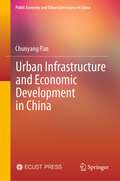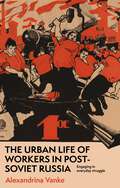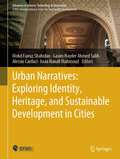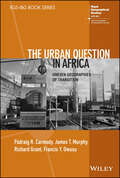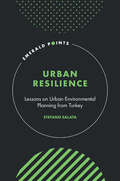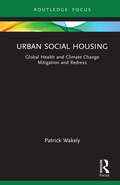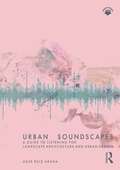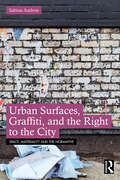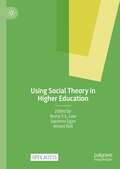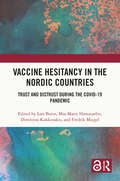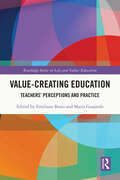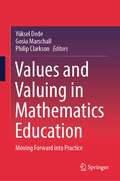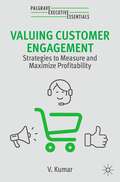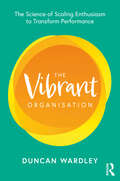- Table View
- List View
Urban Infrastructure and Economic Development in China (Public Economy and Urban Governance in China)
by Chunyang PanThis book provides an overview of the history, basic concepts, and provision models of infrastructure, significant theories on infrastructure economics, practices at home and abroad that reflect the economic development effects of infrastructure, and four infrastructure economic growth models. Great attention is placed on the domestic front. This book describes and discusses in detail the historical background, development trends, achievements, and challenges of China’s infrastructure from 1949 to 2019, under the classic “supply and demand” analysis framework. From the four perspectives of market integration, open development, people’s livelihood, and endogenous growth, this book carries out an empirical study on how to quantify and make causal inferences about the economic development effects of infrastructure. Based on the conclusion that national governance is of important help to infrastructure provision, this book interprets China’s governance system and its impact on infrastructure provision from the angle of decentralization and offers suggestions on policy optimizing.
The urban life of workers in post-Soviet Russia: Engaging in everyday struggle
by Alexandrina VankeDespite the intense processes of deindustrialisation around the world, the working class continues to play an important role in post-industrial societies. However, working-class people are often stigmatised, morally judged and depicted negatively in dominant discourses. This book challenges stereotypical representations of workers, building on research into the everyday worlds of working-class and ordinary people in Russia’s post-industrial cities. The urban life of workers in post-Soviet Russia is centred on the stories of local communities engaged in the everyday struggles that occur in deindustrialising settings under neoliberal neo-authoritarianism. The book suggests a novel approach to everyday life in post-industrial cities. Drawing on an ethnographic study with elements of arts-based research, the book presents a new genre of writing about workers influenced by the avant-garde documentary tradition and working-class literature.
The urban life of workers in post-Soviet Russia: Engaging in everyday struggle
by Alexandrina VankeDespite the intense processes of deindustrialisation around the world, the working class continues to play an important role in post-industrial societies. However, working-class people are often stigmatised, morally judged and depicted negatively in dominant discourses. This book challenges stereotypical representations of workers, building on research into the everyday worlds of working-class and ordinary people in Russia’s post-industrial cities. The urban life of workers in post-Soviet Russia is centred on the stories of local communities engaged in the everyday struggles that occur in deindustrialising settings under neoliberal neo-authoritarianism. The book suggests a novel approach to everyday life in post-industrial cities. Drawing on an ethnographic study with elements of arts-based research, the book presents a new genre of writing about workers influenced by the avant-garde documentary tradition and working-class literature.
Urban Narratives: Exploring Identity, Heritage, and Sustainable Development in Cities (Advances in Science, Technology & Innovation)
by Mohd Fairuz Shahidan Gasim Hayder Ahmed Salih Alessio Cardaci Israa Hanafi MahmoudThis book engages readers in an enlightening exploration of cities' identities, sustainability, and urban development. Delving into the intricate interplay between art, architecture, and the urban landscape, it offers a compelling analysis of the factors that shape cities and their distinct personalities. The volume uncovers captivating stories of cities as they navigate the delicate balance between heritage conservation and modernity. It highlights innovative strategies employed to preserve historical sites while adapting to the demands of a rapidly changing world. Full of insightful discussions on the impact of cultural lifestyles, the fusion of architectural styles, and the challenges and triumphs of sustainable urban development, it draws upon a diverse range of perspectives and research, inviting architects, urban planners, and scholars to delve into the intricate nuances of cities' identities in the process.With its informative and engaging narrative, this book providesa fresh perspective on cities' identities and offers practical insights into shaping vibrant, livable urban landscapes.
The Urban Question in Africa: Uneven Geographies of Transition (RGS-IBG Book Series)
by Padraig R. Carmody James T. Murphy Richard Grant Francis Y. OwusuIlluminates the path to more generative urban transitions in Africa's cities and developing rural areas Africa is the world's most rapidly urbanizing region. The predominantly rural continent is currently undergoing an “urban revolution” unlike any other, generally taking place without industrialization and often characterized by polarization, poverty, and fragmentation. While many cities have experienced construction booms and real estate speculation, others are marked by expanding informal economies and imploding infrastructures. The Urban Question in Africa: Uneven Geographies of Transition examines the imbalanced and contested nature of the ongoing urban transition of Africa. Edited and authored by leading experts on the subject, this unique volume develops an original theory conceptualizing cities as sociotechnical systems constituted by production, consumption, and infrastructure regimes. Throughout the book, in-depth chapters address the impacts of current meta-trends—global geopolitical shifts, economic changes, the climate crisis, and others—on Africa's cities and the broader development of the continent. Presents a novel framework based on extensive fieldwork in multiple countries and regions of the continent Examines geopolitical and socioeconomic topics such as manufacturing in African cities, the green economy in Africa, and the impact of China on urban Africa Discusses the prospects for generative urbanism to produce and sustain long-term development in Africa Features high-quality maps, illustrations, and photographsThe Urban Question in Africa: Uneven Geographies of Transition is essential reading for undergraduate and postgraduate students in geography, urban planning, and African studies, academic researchers, geographers, urban planners, and policymakers.
The Urban Question in Africa: Uneven Geographies of Transition (RGS-IBG Book Series)
by Padraig R. Carmody James T. Murphy Richard Grant Francis Y. OwusuIlluminates the path to more generative urban transitions in Africa's cities and developing rural areas Africa is the world's most rapidly urbanizing region. The predominantly rural continent is currently undergoing an “urban revolution” unlike any other, generally taking place without industrialization and often characterized by polarization, poverty, and fragmentation. While many cities have experienced construction booms and real estate speculation, others are marked by expanding informal economies and imploding infrastructures. The Urban Question in Africa: Uneven Geographies of Transition examines the imbalanced and contested nature of the ongoing urban transition of Africa. Edited and authored by leading experts on the subject, this unique volume develops an original theory conceptualizing cities as sociotechnical systems constituted by production, consumption, and infrastructure regimes. Throughout the book, in-depth chapters address the impacts of current meta-trends—global geopolitical shifts, economic changes, the climate crisis, and others—on Africa's cities and the broader development of the continent. Presents a novel framework based on extensive fieldwork in multiple countries and regions of the continent Examines geopolitical and socioeconomic topics such as manufacturing in African cities, the green economy in Africa, and the impact of China on urban Africa Discusses the prospects for generative urbanism to produce and sustain long-term development in Africa Features high-quality maps, illustrations, and photographsThe Urban Question in Africa: Uneven Geographies of Transition is essential reading for undergraduate and postgraduate students in geography, urban planning, and African studies, academic researchers, geographers, urban planners, and policymakers.
Urban Resilience: Lessons on Urban Environmental Planning from Turkey (Emerald Points)
by Stefano SalataAdvocating for the reintroduction of natural areas and biodiverse green spaces within our cities, Urban Resilience stems from the two years’ experience living and teaching ecological planning in Turkey. What is resilience? What does it mean practically to design resilient cities? Demonstrating that the expansion of the ecological footprint of urban areas is no longer sustainable, Stefano Salata underscores that authentic resilience in urban planning necessitates embracing the reduction and de-sealing of urban surfaces, which he advocates for as the sole viable means of confronting the challenges posed by climate change. Providing a fresh methodological outlook on urban adaptation, Salata introduces a novel approach to understanding resilience, streamlining the key components of knowledge that urban planners need to acquire in order to effectively address the challenges posed by climate change. Supplemented with short personal reflections on Turkish space and society, this study explores the societal significance of embracing a new cultural paradigm characterized by reduced consumerism. Taking the Turkish case as a pioneering testing ground, Salata substantiates the potential of resilient approaches for urban transformation, affording us the opportunity to evaluate the efficacy of various solutions across the globe.
Urban Resilience: Lessons on Urban Environmental Planning from Turkey (Emerald Points)
by Stefano SalataAdvocating for the reintroduction of natural areas and biodiverse green spaces within our cities, Urban Resilience stems from the two years’ experience living and teaching ecological planning in Turkey. What is resilience? What does it mean practically to design resilient cities? Demonstrating that the expansion of the ecological footprint of urban areas is no longer sustainable, Stefano Salata underscores that authentic resilience in urban planning necessitates embracing the reduction and de-sealing of urban surfaces, which he advocates for as the sole viable means of confronting the challenges posed by climate change. Providing a fresh methodological outlook on urban adaptation, Salata introduces a novel approach to understanding resilience, streamlining the key components of knowledge that urban planners need to acquire in order to effectively address the challenges posed by climate change. Supplemented with short personal reflections on Turkish space and society, this study explores the societal significance of embracing a new cultural paradigm characterized by reduced consumerism. Taking the Turkish case as a pioneering testing ground, Salata substantiates the potential of resilient approaches for urban transformation, affording us the opportunity to evaluate the efficacy of various solutions across the globe.
Urban Social Housing: Global Health and Climate Change Mitigation and Redress
by Patrick WakelyThis book proposes operational approaches to public sector support to community-led development of urban low-income group social housing in the prevailing and medium-term. Within the context of mitigating and redressing the existential threats of climate change and global pathogenic transmission, building on current concerns of global heating and the lessons learnt from the 2020-22 COVID-19 pandemic, the book closely examines recent examples from a wide international range of countries and cities from the Sri Lanka experience to Arab States of the Middle East and the Andes. Topics include maintenance and management of public sector housing, poverty alleviation objectives, climate change mitigation, housing density, local land management and planning, land rights, affordable housing markets, and international governance and administration, ultimately pointing to the universal need for institutional, organisational and human skills development and the compilation and dissemination of operationally successful examples of participatory partnerships for affordable social housing. The book will be of interest to researchers, instructors, practitioners, and students of urban development, housing, environmental design, land-use planning, public administration and environmental health engineering.
Urban Social Housing: Global Health and Climate Change Mitigation and Redress
by Patrick WakelyThis book proposes operational approaches to public sector support to community-led development of urban low-income group social housing in the prevailing and medium-term. Within the context of mitigating and redressing the existential threats of climate change and global pathogenic transmission, building on current concerns of global heating and the lessons learnt from the 2020-22 COVID-19 pandemic, the book closely examines recent examples from a wide international range of countries and cities from the Sri Lanka experience to Arab States of the Middle East and the Andes. Topics include maintenance and management of public sector housing, poverty alleviation objectives, climate change mitigation, housing density, local land management and planning, land rights, affordable housing markets, and international governance and administration, ultimately pointing to the universal need for institutional, organisational and human skills development and the compilation and dissemination of operationally successful examples of participatory partnerships for affordable social housing. The book will be of interest to researchers, instructors, practitioners, and students of urban development, housing, environmental design, land-use planning, public administration and environmental health engineering.
Urban Soundscapes: A Guide to Listening for Landscape Architecture and Urban Design
by Usue Ruiz AranaSound and listening are intrinsically linked to how we experience and engage with places and communities. This guide puts forward a new conceptual framework of embodied affectivity that emphasises listening in urban research and design and advances new ways of knowing and making. The guide invites landscape architects and urban designers to become soundscape architects and offers practical advice on sound and listening applicable to each stage of a design project: from reading the environment to intervening on it.Urban Soundscapes foregrounds listening as an affective mediator between subjects and multispecies environments, and a vehicle to think and conceptualise environmental research and design beyond prevailing visual and human-centred modes. The guide expands landscape architects’ and urban designers’ tools and skills to assess existing soundscapes, predict how those soundscapes will be altered through their designs, consider sound as a creative and active part of the design process and envisage how users might perceive and be affected by those soundscapes as they evolve in time. The volume sits in the interface of research and practice and interweaves theoretical, methodological and creative contributions from acoustic ecology, ecoacoustics, bioacoustics and sound art. Each of the design stages is illustrated through project examples that demonstrate the many advantages of incorporating attentive listening and sound into Landscape Architecture and Urban Design Practice. This book shows how incorporating listening and sounding as part of the design process promotes slow and subtle ways of practice, adds social and ecological value through the reduction of noise pollution and by monitoring the health of habitats, and enables the design of soundscapes that complement the character and design intent of a scheme and elicit joy and wonder.The book will be of interest to practitioners and academics in landscape architecture, and other design and spatial fields such as urban design, architecture, geography and engineering, who play a primary role in the composition of the soundscape.
Urban Soundscapes: A Guide to Listening for Landscape Architecture and Urban Design
by Usue Ruiz AranaSound and listening are intrinsically linked to how we experience and engage with places and communities. This guide puts forward a new conceptual framework of embodied affectivity that emphasises listening in urban research and design and advances new ways of knowing and making. The guide invites landscape architects and urban designers to become soundscape architects and offers practical advice on sound and listening applicable to each stage of a design project: from reading the environment to intervening on it.Urban Soundscapes foregrounds listening as an affective mediator between subjects and multispecies environments, and a vehicle to think and conceptualise environmental research and design beyond prevailing visual and human-centred modes. The guide expands landscape architects’ and urban designers’ tools and skills to assess existing soundscapes, predict how those soundscapes will be altered through their designs, consider sound as a creative and active part of the design process and envisage how users might perceive and be affected by those soundscapes as they evolve in time. The volume sits in the interface of research and practice and interweaves theoretical, methodological and creative contributions from acoustic ecology, ecoacoustics, bioacoustics and sound art. Each of the design stages is illustrated through project examples that demonstrate the many advantages of incorporating attentive listening and sound into Landscape Architecture and Urban Design Practice. This book shows how incorporating listening and sounding as part of the design process promotes slow and subtle ways of practice, adds social and ecological value through the reduction of noise pollution and by monitoring the health of habitats, and enables the design of soundscapes that complement the character and design intent of a scheme and elicit joy and wonder.The book will be of interest to practitioners and academics in landscape architecture, and other design and spatial fields such as urban design, architecture, geography and engineering, who play a primary role in the composition of the soundscape.
Urban Surfaces, Graffiti, and the Right to the City (ISSN)
by Sabina AndronThis landmark book focuses on urban surfaces, on exploring their authorship and management, and on their role in struggles for the right to the city.Graffiti, pristine walls, advertising posters, and municipal signage all compete on city surfaces to establish and imprint their values on our environments. It is the first time that the surfacescapes of our cities are granted the entire attention of a book as material, visual, and legal territories. The book includes a critical history of graffiti and street art as contested surface discourses and argues for surfaces as sites of resistance against private property, neoliberal creativity, and the imposition of urban order. It also proposes a seven-point manual for a semiotics of urban surfaces, laying the ground for a new discipline: surface studies.Page after page and layer after layer, surfaces become porous and political and emerge as key spatial conditions for rethinking and re-practicing urban dwelling and spatial justice. They become what the author terms the surface commons.The book will appeal to a wide readership across the disciplines of urban studies, architectural theory and design, graffiti, street art and public art, criminology, semiotics, visual culture, and urban and legal geography. It will also serve as a tool for city scholars, policy makers, artists, and vandals to disrupt existing imaginaries of order, justice, and visibility in cities.
Urban Surfaces, Graffiti, and the Right to the City (ISSN)
by Sabina AndronThis landmark book focuses on urban surfaces, on exploring their authorship and management, and on their role in struggles for the right to the city.Graffiti, pristine walls, advertising posters, and municipal signage all compete on city surfaces to establish and imprint their values on our environments. It is the first time that the surfacescapes of our cities are granted the entire attention of a book as material, visual, and legal territories. The book includes a critical history of graffiti and street art as contested surface discourses and argues for surfaces as sites of resistance against private property, neoliberal creativity, and the imposition of urban order. It also proposes a seven-point manual for a semiotics of urban surfaces, laying the ground for a new discipline: surface studies.Page after page and layer after layer, surfaces become porous and political and emerge as key spatial conditions for rethinking and re-practicing urban dwelling and spatial justice. They become what the author terms the surface commons.The book will appeal to a wide readership across the disciplines of urban studies, architectural theory and design, graffiti, street art and public art, criminology, semiotics, visual culture, and urban and legal geography. It will also serve as a tool for city scholars, policy makers, artists, and vandals to disrupt existing imaginaries of order, justice, and visibility in cities.
Urbane Mixturen: Städtebau und Stadtplanung als relationales Handlungsfeld (Urban Studies)
by Christian Peer Angelika PsennerZeitgemäße Stadtplanungskonzepte setzen die städtebauliche Mischung als Grundprinzip voraus und erkennen darin eine zwar herausfordernde, aber notwendige Praxis. In der Umsetzung ist sie jedoch umstritten und bleibt oft unerreicht oder im Ergebnis überraschend andersartig. Die Beiträger*innen setzen sich kritisch mit Aspekten der urbanen Mischung und der damit verknüpften Rolle von Architektur und Planung auseinander. Sie beleuchten Widersprüche und Herausforderungen und nennen Beispiele für neuartige Perspektiven und Qualitäten des Urbanen, für deren Sinnhaftigkeit, Erfolg oder Scheitern. Ihre Analysen liefern Grundlagen für das gegenwärtige und zukünftige kollaborative Planen und Bauen.
Using Social Theory in Higher Education
by Remy Y. S. Low Suzanne Egan Amani BellThis open access book offers a unique and refreshing view on working with social theory in higher education. Using engaging first-person accounts coupled with critical intellectual analysis, the authors demonstrate how theory is grappled with as part of an ongoing practice rather than a momentary disembodied encounter. In a structure that creates a space for relational dialogue, each chapter is followed by a response from another author, demonstrating the varied interpretive possibilities of social theory. Collectively the authors invite the reader to engage with them in questioning the usefulness of social theory in higher education teaching and research, in considering its possibilities and limits, and in experiencing the opportunity it offers to understand ourselves and our work differently. Written in a way that is scholarly yet accessible, the contributors explore how social theories can be used to think through issues that are emerging as key social and political concerns in higher education and beyond. The book will be of interest to advanced undergraduates, postgraduates, and early-career academics, as well as established scholars.
Vaccine Hesitancy in the Nordic Countries: Trust and Distrust During the COVID-19 Pandemic
Bringing together studies from across the Nordic region, this book examines the challenges brought by the COVID-19 pandemic, with a particular focus on vaccine hesitancy. Shedding light on the political tensions that emerged as a result of the pandemic and the debates that ensued both within and between the Nordic nations, it investigates the vociferous discussions surrounding the COVID-19 vaccines and their presumed negative side effects through the lens of trust; trust in and between the neighbouring countries, in healthcare systems, fellow citizens, and experts; in public authorities, politicians, researchers, journalists, and pharmaceutical companies. The first volume to explore vaccine hesitancy in the Scandinavian context, this ground-breaking volume offers fresh perspectives on vaccine scepticism not as a form of ignorance or lack of knowledge, but as a manifestation of a more fundamental lack of faith in modern government and science. As such, it will appeal to scholars of sociology, politics, anthropology, media studies, communication and cultural studies with interests in public health, popular and political discourse and questions of public trust.The Open Access version of this book, available at http://www.taylorfrancis.com, has been made available under a Creative Commons [Attribution-Non Commercial-No Derivatives (CC-BY-NC-ND)] 4.0 license.
Vaccine Hesitancy in the Nordic Countries: Trust and Distrust During the COVID-19 Pandemic
by Lars Borin Mia-Marie Hammarlin Dimitrios Kokkinakis Fredrik MiegelBringing together studies from across the Nordic region, this book examines the challenges brought by the COVID-19 pandemic, with a particular focus on vaccine hesitancy. Shedding light on the political tensions that emerged as a result of the pandemic and the debates that ensued both within and between the Nordic nations, it investigates the vociferous discussions surrounding the COVID-19 vaccines and their presumed negative side effects through the lens of trust; trust in and between the neighbouring countries, in healthcare systems, fellow citizens, and experts; in public authorities, politicians, researchers, journalists, and pharmaceutical companies. The first volume to explore vaccine hesitancy in the Scandinavian context, this ground-breaking volume offers fresh perspectives on vaccine scepticism not as a form of ignorance or lack of knowledge, but as a manifestation of a more fundamental lack of faith in modern government and science. As such, it will appeal to scholars of sociology, politics, anthropology, media studies, communication and cultural studies with interests in public health, popular and political discourse and questions of public trust.The Open Access version of this book, available at http://www.taylorfrancis.com, has been made available under a Creative Commons [Attribution-Non Commercial-No Derivatives (CC-BY-NC-ND)] 4.0 license.
Value-Creating Education: Teachers’ Perceptions and Practice (Routledge Series on Life and Values Education)
by Emiliano Bosio Maria GuajardoOffering a pivotal reference point and a wide range of global perspectives of teaching experiences on value-creating education (VCE), this book is a timely spotlight on contemporary issues of globalisation that many educational institutions around the world may encounter. It contributes to the originality of constructing new knowledge in the field of VCE, a forward-looking framework, and an ethical and educational imperative that can be understood in different ways, from diverse theoretical orientations. The chapters written by experienced international educators explore the following questions: How do educators understand the role of VCE? What pedagogical approaches to VCE do educators employ in their classes? How do educators support the values and knowledge of VCE in all curricular areas? What do educators see as the key essential values and knowledge that students should develop through VCE? It offers valuable insights and applied pedagogical practices for postgraduate students, researchers, educational policy makers, curriculum developers, and decision-makers in higher education institutions and non-governmental organizations (e.g., UNESCO, OXFAM).
Value-Creating Education: Teachers’ Perceptions and Practice (Routledge Series on Life and Values Education)
by Emiliano Bosio Maria GuajardoOffering a pivotal reference point and a wide range of global perspectives of teaching experiences on value-creating education (VCE), this book is a timely spotlight on contemporary issues of globalisation that many educational institutions around the world may encounter. It contributes to the originality of constructing new knowledge in the field of VCE, a forward-looking framework, and an ethical and educational imperative that can be understood in different ways, from diverse theoretical orientations. The chapters written by experienced international educators explore the following questions: How do educators understand the role of VCE? What pedagogical approaches to VCE do educators employ in their classes? How do educators support the values and knowledge of VCE in all curricular areas? What do educators see as the key essential values and knowledge that students should develop through VCE? It offers valuable insights and applied pedagogical practices for postgraduate students, researchers, educational policy makers, curriculum developers, and decision-makers in higher education institutions and non-governmental organizations (e.g., UNESCO, OXFAM).
Values and Valuing in Mathematics Education: Moving Forward into Practice
by Yüksel Dede Gosia Marschall Philip ClarksonThis book is a follow-up to 'Values and Valuing in Mathematics Education: Scanning and Scoping the Territory' (2019, Springer). This book adds a critical emphasis on practice and fosters thinking concerning positive mathematical well-being, engagement, teacher noticing, and values alignment among a range of critical notions that intersect with values and valuing. Values and valuing play a key role in many aspects of education, such as assessment, planning, classroom interactions, choosing tasks, and general well-being. What one values and finds important in the learning and teaching of mathematics operates within the intersection of all social, cognitive, and affective aspects of school pedagogy, making values a significant holistic factor in education. The chapters explore potential teaching strategies that enhance the understanding of the central place of values in mathematics itself as a subject, as well as how values impact how mathematics is used withinsociety. This book includes examples of strategies for facilitating students’ meaningful engagement with, and conscious learning of, values when engaging in mathematical thinking and doing.
Valuing Customer Engagement: Strategies to Measure and Maximize Profitability (Palgrave Executive Essentials)
by V. KumarIn recent years, the concept of customer engagement has evolved as a powerful tool in the managerial toolkit of firms to incorporate a profitable approach to customer management. There is a pressing need for an authoritative book that communicates the fundamentals of profitable customer engagement by proposing a customer engagement value framework. This book, Valuing Customer Engagement, is first of its kind on customer engagement that outlines the theory and methods of engaging customers profitably in business-to-consumer and business-to-business settings.Written by world-renowned scholar and thought leader V. Kumar, this seminal work book explains the definitions of the metrics within the CEV framework and analyzes ways to measure and maximize these metrics that can help in engaging customers profitably. Dr. Kumar also reveals the interrelationships between these metrics, i.e. how each metric impacts the other, with examples from all over the world.This updated edition introduces of Customer Valuation Theory as a way of quantifying direct and indirect engagement value while presenting newer applications and case studies. With practical examples of companies that have benefited by implementing these strategies, this guide is a must have for business executives who want to maximize companies profitability as well as students wanting to learn how to engage customers and build loyalty.
Verlust, Abschied und Trauer in der Physiotherapieausbildung: Evaluation eines Unterrichtskonzeptes vor dem ersten Patientenkontakt (BestMasters)
by Adrian RodenVerlust, Abschied und Trauer sind Themen, die in der heutigen Zeit gerne übergangen werden. Wenn man im Rahmen der physiotherapeutischen Arbeit regelmäßig damit konfrontiert wird, dann ist es für Lehrende als Pflicht anzusehen, diese Themen adäquat innerhalb der Ausbildung adressieren zu können. So geht es hierbei nicht nur um den Selbstschutz von Therapeut*innen, sondern auch um eine Befundung von Patient*innen auf allen Ebenen des bio-psycho-sozialen Modells der ICF und somit auch um eine zielführende Therapie. Der Großteil deutscher Lehrpläne umgeht die vermeintlich unangenehme Thematik oder spiegelt antiquierte Sichtweisen wider. Erklärtes Ziel der dreijährigen Ausbildung ist der Erwerb der beruflichen Handlungskompetenz. Zu dieser zählt der Autor unter anderem die emotionale Kompetenz. Die vorliegende Arbeit zeigt didaktische und methodische Ansätze auf, um die Themen Verlust, Abschied und Trauer im Kontext des bio-psycho-sozialen Modells in die Ausbildung zu integrieren und einen bestmöglichen Erfolg in Form einer Steigerung der emotionalen Kompetenz anzustreben.
The Vibrant Organisation: The Science of Scaling Enthusiasm to Transform Performance
by Duncan WardleyThe Vibrant Organisation translates the science of human behaviour into a playbook of highly practical interventions that build and scale enthusiasm, transforming organisational culture and performance. The book helps create more joy and fulfilment at work, whilst also steering a path to sustained competitive advantage. Using cutting-edge research in neuroscience and psychology, as well as the author’s considerable practical experience, Duncan Wardley offers a three-part framework for building teams of agile, adaptable, curious, and highly motivated people: Reset shows how to reduce the threat response by creating a safe environment for employees Ignite teaches leaders how to create events or experiences that create flashes of insight and motivation Fuel demonstrates how to sustain people’s motivation through repeatable actions, resulting in an upward spiral of enthusiasm. Packed with fascinating research, on-the-ground stories, and new scientific findings – along with practical tools and exercises – The Vibrant Organisation is a must read for business leaders at all levels looking to get the best out of themselves and their people.
The Vibrant Organisation: The Science of Scaling Enthusiasm to Transform Performance
by Duncan WardleyThe Vibrant Organisation translates the science of human behaviour into a playbook of highly practical interventions that build and scale enthusiasm, transforming organisational culture and performance. The book helps create more joy and fulfilment at work, whilst also steering a path to sustained competitive advantage. Using cutting-edge research in neuroscience and psychology, as well as the author’s considerable practical experience, Duncan Wardley offers a three-part framework for building teams of agile, adaptable, curious, and highly motivated people: Reset shows how to reduce the threat response by creating a safe environment for employees Ignite teaches leaders how to create events or experiences that create flashes of insight and motivation Fuel demonstrates how to sustain people’s motivation through repeatable actions, resulting in an upward spiral of enthusiasm. Packed with fascinating research, on-the-ground stories, and new scientific findings – along with practical tools and exercises – The Vibrant Organisation is a must read for business leaders at all levels looking to get the best out of themselves and their people.
